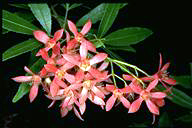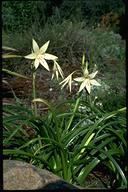

 |
Australian National Botanic Gardens
|
 |
A weekly news sheet prepared by a Gardens' volunteer.
Numbers in square brackets [] refer to garden bed Sections.
Plants in flower are in bold type.
6 February 2004
 |
|
Ceratopetalum gummiferum
(NSW Christmas Bush) - click for larger image
|
Even if you saw nothing else, just come to the Gardens to behold the spectacle of the gorgeous New South Wales Christmas Bush, Ceratopetalum gummiferum [Section 142], on the left hand side of the entrance to the Tasmanian Garden! The stand of lovely slender trees, laden with tresses of creamy salmon pink/red five petaled wannabe flowers (they are in fact remnants of the white star-like spring flowers; reddened swollen calyces which fool even the bees!) is visible from almost anywhere in the car park.
Starting with the patch of Western Australian Kangaroo Paws, Anigozanthos flavidus [Section 171] on the opposite side of that path, observe the colour variations of this plant throughout the Gardens as you wander and pass numerous clumps on your way to the waterfall in the Rockery [Section 15]. Blood red, burnt red, rust, lime greens, oranges, yellows, pinks and combinations – what next! Looking closer at its very interesting flower, you will see that it is always presented towards the bird visitor it is expecting on its long and strong slender stalk, offering its nectar/pollen, then turning away when pollinated/spent.
In front of the Waterfall in the Rockery stands a stout and proud little Eucalyptus extrica [Section 15V] frothing with white gum-flowers, while Grevillea ‘Poorinda Royal Mantle’ [Section 15D] cloaks the steep bank on the left. At the steps behind it, on the left hand side, is Crinium flaccidum [Section 15C], the large white Darling Lily, and a little further up, left and right, is Calostemma purpureum [Section 15B, F], the Garland Lily, with heads of 12 or more smaller trumpet-like wine-red flowers, yellow trumpets within. On the way back down on your left, Xanthorrhoea macronema [Section 15D], trunkless and displaying an unusual almost banksia-like flower spear, is more than subtly different from the other grass trees.
 |
|
Crinum flaccidum
- click for larger image
|
Back on the Main Path into the Conifer Section, notice on your left the fresh crop of seeds, on plum-like fleshy stems, appearing on the Plum Pine, Podacarpus elatus [Section 110]. The Wallum Banksia, Banksia aemulata [Section 16], a little further along on the right, now has a bush-load of fresh cream (tinged pale lime) flower cones at all stages of maturation amongst its previous years’ brushes with their big woody follicles. Further along on the left is a very happy Geebung, Persoonia pinifolia [Section 110], lit up by its terminal spikes of yellow flowers, looking like bunches of grapes when its fruit sets. Opposite it, to the left of the entrance to the Conifer Loop, Athrotaxis laxifolia [Section 80], a pencil-pine-like conifer from Tasmania, is sprouting small spherical cones, like baubles. Continuing along the Main Path, at the end of this section on the right hand side, find Backhousia citriodora [Section 80], the very fragrant Lemon Myrtle, punching out its furry little fistfuls of white flowers.
As you enter the Rainforest, Alocasia macrorrhizos [Section 114], huge leaves catching the sun on your left, now has spathe-like green/white flowers emerging, the rod (spadix) inside turning from green/cream to bright orange and brown. High above you the two Coachwoods, Ceratopetalum apetalum [Section 146] are fully out in flower, as are the very tall Wattles, Acacia elata [Section 146] behind it.
Continue along the Main Path, passing Burrawangs, Lepidozamia peroffskyana [Section 146, 160] both on the left and right, about to fan out their new set of leaves. Across the bridge, turn left and enjoy the downhill stroll through this edge of the Rainforest, so sensuously quiet in the evening (the Gardens remain open until 8pm this month). You and the birds, that’s all (if you brought the Aerogard!).
Exit at the end of the footbridge, continue along the Main (pebblecrete) Path, past the babbling brook. On the right several Correa glabra (green flowered form)[Section 212] plants look like they’ve been decorated with glow-in-the-dark little lanterns.
That was such a lovely evening walk! Sally